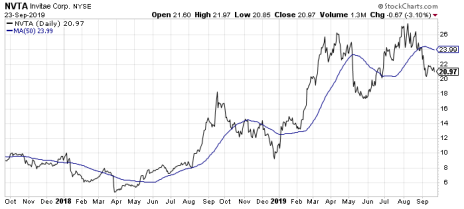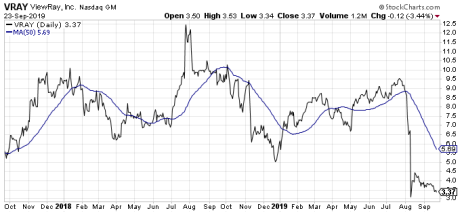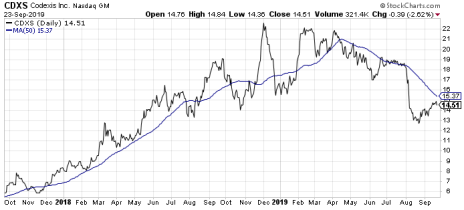These Small-Cap MedTech Stocks are Poised to Outperform in the Next Year
With all the recent market volatility the big question on the minds of investors is whether or not right now is a buying opportunity. I won’t try to convince you one way or the other. But if you’re interested in high-growth, small-cap MedTech stocks that could do well over the next year, here are three names that should pique your interest. You can decide for yourself if it’s worth taking a position in these stocks right now!
3 Small-Cap MedTech Stocks to Buy
Small-Cap MedTech Stock #1: Invitae (NVTA)
Invitae is a genetic information company with a $2 billion market cap that’s working to bring comprehensive genetic information into mainstream medical practice. The company specializes in genetic diagnostics across all stages of life, including perinatal, prenatal, pediatric and adult. Management has been working to pool genetic tests into a single service that could be offered at a lower price than current alternatives, while delivering faster turnaround time.




Invitae’s growth strategy is relatively simple. By making genetic testing more accessible and affordable it expects to supply a large volume of tests. It’s also building a genome network through partnerships with industry peers and working to share genetic information on a global scale through services that inform healthcare throughout life.
It’s simple to write on paper, but harder to implement. That said, Invitae is having tremendous success. In 2016 it had only 6 million covered lives in network. That number is up to 275 million as of the end of Q1 2019. Testing volume was up 52%, to 111,000 tests in Q2 2019 alone.
Part of this is because the company’s network of biopharma partnerships is expanding. It now has over 50 biopharma partnership programs in network, and also because the company is fulfilling its promise to lower costs. The average cost of a test now sits at $252, well below the cost of $1,300 from 2014.
Sales are ramping up. Invitae’s revenue was up 117% in 2018 and 43%, to $53.5 million, in Q2 2019. Analysts expect the company will deliver over 500,000 sample tests and generate $220 million in sales (up 47%) this year. EPS will likely decline modestly to -$2.16.
With such bright potential why isn’t Invitae’s stock soaring? The short version is that many of these genetic testing stocks have done poorly in recent months. And in Q1 2019 Invitae posted lighter-than-expected testing volume. That revealed the seasonal nature of the business, and testing volume is expected to be light in the current quarter (Q3 2019) as well.
Still, the big picture, bullish trends remain intact. Invitae is working to bring genetic testing to the masses at a lower price. Revenue should grow 50% in 2020, when the EPS loss should improve by around $0.30, to -$1.85. Given that the business appears to be healthy the best way to play the weakness is to average into a position over time.
Small-Cap MedTech Stock #2: ViewRay (VRAY)
ViewRay is a $332 million market cap company that makes MRI-guided radiation therapy systems that are used for imaging and treating cancer patients. Its MRIdian solution integrates MRI technology, radiation delivery and proprietary software to simultaneously image and treat cancer patients.
The technology is most interesting because, as compared to traditional radiation therapy systems known as linear accelerators (linacs), MRIdian appears better at targeting tumors while avoiding healthy tissue and can personalize treatment depending on a patient’s anatomy and tumor location/size.
According to Morgan Stanley the gen 2 MRIdian’s approval in the U.S., Japan and Europe means the solution is competing against an estimated 12,000 linacs and annual purchase volume of roughly 900 units. There is competition out there, mainly from Elekta, MRIdian has a high price point and adoption from its most likely customers (large academic centers and community centers) is still unknown given ViewRay is relatively early in the MRIdian launch.
Point being, the stock is not without risks.
However, if you’re still reading about ViewRay I suspect you’re not a risk-averse investor! And at the current price well under 5.00 risk tolerant investors looking for beaten down MedTech stocks might be tempted.
So, what’s the deal? Revenue was up 135% in 2018, then fell by 23% in Q1 and jumped 84%, to $30.2 million, in Q2 2019.
The problem was that Q2 was full of issues. While ViewRay sold five units (one more than analysts expected), it only received three new orders. That’s less than half of the eight that analysts expected. Management attributed the miss to a mix of distributor issues, young sales teams and, potentially, the relatively high price point of $6 million to $7 million per unit. None of those are easy fixes and clearly mean the launch is challenged.
Management reduced full-year guidance by 26% ($30 million) to $87.5 million (at the midpoint) and 12 to 15 systems (down from 17 to 19), increased cash burn guidance by $15 million (to $80 million to $90 million) and said it’s working on new selling strategies for MRIdian.
All of this has put a big old dent in investor confidence given that ViewRay has more challenges to overcome if it’s to disrupt the radiation therapy market with MRIdian.
Stepping back, radiation oncology isn’t an easy business to break into. Investors shouldn’t rule out slow adoption of MRIdian and/or an eventual sale of the company. On the flip side, management could execute better in 2020 and/or the business could attract buyers that see the potential and can build the units at a lower price and sell more effectively through established sales forces. That could translate to a share price far above where this beaten down MedTech stock is trading right now.
Small-Cap MedTech Stock #3: Codexis (CDXS)
Codexis (CDXS) is a protein engineering company that specializes in the discovery, development and commercialization of novel proteins. These engineered proteins, also known as biocatalysts and/or enzymes, are used in a wide range of industries to make manufacturing processes faster, cleaner and more efficient.
Historically, naturally occurring proteins have been used to produce or add desirable characteristics to many of the products we all use on a daily basis. But in their natural form proteins come up against inherent barriers that limit their commercial potential.
Codexis has developed a proprietary protein engineering technology platform, CodeEvolver, to engineer novel proteins that overcome those inherent limitations. This opens the door to a huge range of uses in customer products, manufacturing processes, and other commercial dimensions.
Its proteins catalysts help customers manufacture products at a lower cost and with lower fixed capital investment. They also reduce the cost of development of complex chemical synthesis processes and can even eliminate entire steps from chemical production. And they allow for the manufacture of purer end-products with lower levels of impurities.
When the California-based company started in 2002 it first targeted the pharmaceuticals industry. Over the 17 years that it’s been developing CodeEvolver, Codexis has expanded into food and nutrition, molecular diagnostics, biotherapeutics, agriculture and other industries.
The company develops proprietary novel biotherapeutics, but the bulk of revenue comes through products and R&D work done with partners, including Merck (MRK), GlaskoSmithKline (GSK), Novartis (NVS), Tate & Lyle (TATYY) and Nestlé Health Sciences.
Over the last four years Codexis has grown its total pipeline of protein innovations from 26 to 43. Eleven of these are being developed on Codexis’ dime, while the remaining 23 are partnered with customers. Nine have been commercialized and are generating revenue right now.
Despite all the progress, one of the issues is that Codexis’ revenue can be a bit lumpy since it comes from both product sales and R&D agreements. The timing of customer manufacturing schedules and/or clinical trials can have a big impact on sales trends given that the revenue base is somewhat small to begin with.
Revenue was up 20% to $60 million in 2018, should be up 17% this year, then climb by almost 30% in 2020. Adjusted EPS should be -$0.23 this year, then improve to -$0.11 in 2020.
The stock had a nice run in 2018 then began to falter after the Q2 2019 earnings release. That could be attributed to the announcement that the CFO would retire and that Codexis had completed a capital raise to fund higher product development costs. There was also some general weakness in the MedTech space around that time, and the year-over-year trend of decelerating revenue growth in 2019 isn’t a great look. Looking forward, Codexis’ management expects revenue to pick up in the back half of 2019 as new CodeEvolver licenses kick in and new product launches hit the market. The trend since mid-July has been better, but with CDXS 37% off its high this still remains a beaten down stock.
Those are my three favorite small-cap MedTech stocks for the year ahead. To learn what other small-cap stocks I’m currently recommending, just grab a subscription to my Cabot Small-Cap Confidential advisory now.

Learn More

Learn More

Learn More

Learn More
*This post has been updated from an original version.




